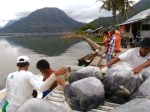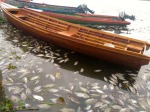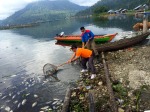- A Maninjau fish farmer beholds a carpet of floating carcasses after the mass death last week.
- The dead fish are carried out of the lake in plastic bags.
- Dead fish in Lake Maninjau.
- Farmers use nets to clean the lake.
Photos: Vinolia
Indonesia: First Toba, now Maninjau: another mass fish death hits an Indonesian lake
It was only the latest fish kill in the volcanic Lake Maninjau, which scientists say is overburdened with too many fish farms.
By Vinolia, translated by Philip Jacobson, 9th September 2016;
- Three thousand tons of farmed fish are thought to have perished in Lake Maninjau, the largest lake in Indonesia’s West Sumatra province.
- The die-off follows a similar incident that occurred in Lake Toba, North Sumatra, in May.
- As in Toba, scientists say there are too many fish farms in Lake Maninjau, exacerbating the natural factors that may have killed the fish.
Another mass fish death has hit Indonesia’s main western island of Sumatra.
Four months after millions of Carp (Cyprinus carpio) and Tilapia (Oreochromis sp.) died suddenly in Lake Toba, the archipelagic country’s biggest lake, a similar incident has occurred in Lake Maninjau nearby.
The latter event is thought to have been twice as deadly. Where in May, 1,500 tons of fish rose lifeless to the surface of Lake Toba, fish farmers in Maninjau said that an estimated 3,000 tons appeared to have perished there on August 31 — and that the losses were financially ruinous.
The Maninjau die-off was also greater in scope. Where in Toba, the fish kill was limited to the floating cages of Haranggaol village, where locals had packed a sheltered bay with vast rows of steel-framed net pens, the Maninjau incident affected several villages around the lake. Toba is 11 times the size of Maninjau and 19 times the size of Manhattan.
The fish in Maninjau appear to have been either poisoned by hydrogen sulfide gas from hydrothermal vents on the lake floor or asphyxiated by a sudden depletion of oxygen in the water. This may have been brought on by an inversion of the lake’s water layers due to strong winds or rains — “extreme weather,” as local officials and fish farmers termed it.
But these natural phenomena are exacerbated by human activity, said environmental geologist Ade Edward Darwin. The first problem is that there are too many fish farms. The lake’s carrying capacity for aquaculture is 6,000 cages, according to the Indonesian Institute of Sciences (LIPI), a government-funded thinktank. At present, 17,000 cages now lie suspended in Maninjau’s waters. Uneaten fish feed and feces from the net pens fuel a process called eutrophication, in which the water becomes excessively rich in nutrients. This nutrient loading can induce oxygen-devouring algal blooms that suffocate fish, as is thought to have happened in Toba in May.
An added complication in the volcanic Lake Maninjau is that sulfur from hydrothermal vents can morph into hydrogen sulfide which poisons fish. Sulfur can also trigger the release of phosphorus from fish-feeding sediments in the lake’s bottom, fueling the eutrophication cycle.
Fish kills are a regular occurrence in Lake Maninjau. In 2009, 7,000 tons of fish turned up dead in the lake. Another major incident happened in 2014. Darwin, the environmental geologist, said the die-offs had been growing in frequency as fish farming expanded. In 2001, a LIPI team visited the lake at the request of the provincial governor and recommended a reduction in the number of cages on the lake. “This could not be implemented by the district government,” Darwin told Mongabay.
When Mongabay visited Maninjau after the latest fish kill, a foul odor hung over the lake. Masses of flies hovered above the stinking pens. The rotting carcasses had begun to mar the water quality. A team from the Agam district fisheries agency was helping residents clean up the lake, using vans and excavators to transport the dead fish. The carcasses were buried in empty fields on the lake’s edge.
Eriandi, a local aquafarmer, said he lost 50 tons of fish and put his losses at nearly 1 billion rupiah ($76,000). “If one kilogram of fish costs 19,000 rupiah [$1.44], one ton of dead fish means a loss of 19 million rupiah,” he said. “If 1,000 tons, that’s 19 billion rupiah [$14.4 million].”
Many of the fish farms are backed by entrepreneurs from outside the area, with farmers going in debt to fund their operations, said Ermanto, head of the Agam district fisheries agency.
“It’s difficult to get them to change their ways because they have multiplied their debts and they want to keep farming so that the debt is paid off,” Ermanto told Mongabay.
Another problem is that farmers tend to use fish feed that sinks instead of the more expensive floating kind.
“For every 10 kilograms of feed dropped into the water, only 6 kilograms at most are absorbed. The remainder accumulates in the lake,” Ermanto said.
Source: Mongabay







